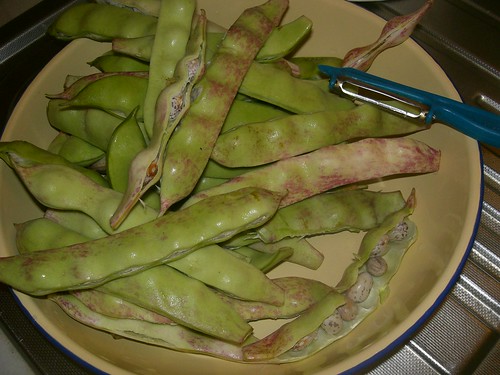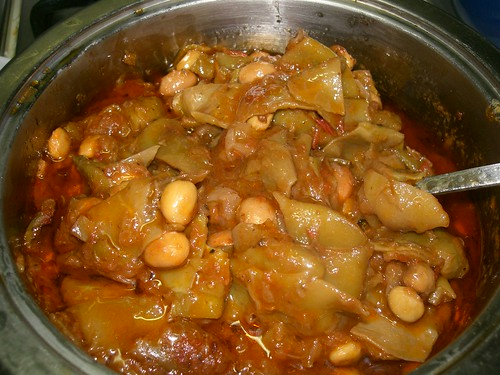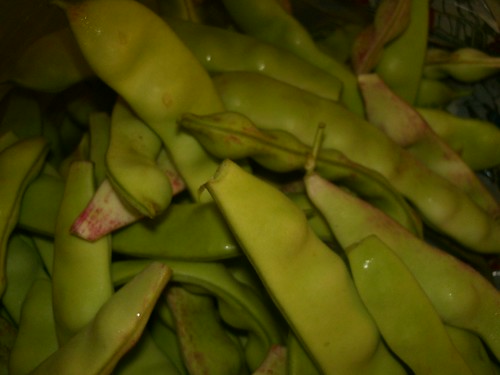Genetically modified organisms have been on the 'bad' list ever since they have been offered as a viable alternative to food. With a growing global population (in 1970 there were 3.5 billion people whereas now there are 6.8 billion people in the world), a shortage of food among the poor and needy (with an excess among the wealthier people in the world) and the use of food as fuel (pushing up the prices for basic commodities and not distributing it to the truly hungry), GMOs are now being viewed more favourably as a solution to these problems (despite the fact that there are more than 300,000 plant species in the world and only 3,000 have ever been used as food; it is believed that there may be another 20,000 species that can be used as for food).
At my workplace, GMOs are investigated as part of the global interest in the advancement and development of agronomic issues, side by side with sustainable agriculture. As an English teacher with no scientific base, I'm not able to expand arguments one way or the other, apart from rendering my own opinion, but I'm in the privileged position to be given the opportunity on a daily basis to read up on the latest developments in both fields, by proofreading such work, from the fieldwork and laboratory experiments my students carry out in both disciplines.
Greece does not allow GMOs in the food chain; on a purely opinionated basis, I'm thankful for that. But this doesn't guarantee that we aren't consuming GMOs. Country borders do not always allow non-GMO crops to stay non-GMO, as the wind direction may cross-pollinate species in neighbouring fields (or even further away), so that what was initially believed to be non-GMO crop may in fact become GMO. Imported products also can't be guaranteed to be GMO-free, especially when they are imported from countries which allow GMO plants to be used as food (eg the US; the mere mention of Monsanto induces fear among those against GMOs), and do not always practice strict controls over the separation of GMO and non-GMO produce. This is especially the case where corn, wheat and rice (as well as other grains) are concerned, as these products are often ground into flour, further reducing their traceability in the food chain.
Most people associate plant growing with soil, sun, fresh air and large expanses of gardens and fields. Ignorance is bliss: countries with very poor soil conditions and/or lack of agricultural land (eg Holland, Israel) have used scientific advances to help them feed their populations by growing their vegetables using a technique known as hydroponics (known also as soilless culture). Holland even exports their hydroponically grown crops all over Europe (such products are also available in Hania). These non-GMO plants are grown under laboratory conditions without soil (they use porous substances like perlite) in a water-based system supplied with nutrients such as calcium, iron and other substances that are found in soil and are necessary for the nutrition of a plant, in the same way that a farmer provides fertiliser to his crops due to soil inadequacies.
Genetically modifying organisms doesn't necessarily mean you're going to end up with a product that looks or tastes different to natural organisms; it more likely means that the product will be easier for the farmer to grow (eg it might be resistant to common plant diseases), or it might have a better storage life (eg a tomato that doesn't have a good shelf life won't keep its shape and texture as well as one that can be kept in storage longer once it is picked). What many people don't realise is that for years (literally) farmers have been using natural selection to grow crops which exhibit better growing and keeping qualities. In other words, they have been selecting plants that show better genes than others, and these are what we mainly eat today. It's not as simple as organic vs. GMO; hybrid crop species are the result of interbreeding different varieties of crops that have desirable genetic features: that's how we get seedless watermelons, for instance. GMO technology gives this 'natural' selection procedure a helping hand by quickening its pace.
*** *** ***
Barbounofasoula - a bean variety of the common Phaesolus vulgaris - are members of the common runner bean. They have a beautiful mottled purple-white appearance, both on the pod and the bean. They're very popular in Greece in early summer. When I buy these, I never look to find an organic label near them; I look for other qualities. If they aren't picked and delivered fresh to the store for the customers to purchase, the pod starts to wilt, or it may be too fibrous to eat, even when cooked. They are sold with the pod, so it would be a waste of your precious cash (they are more expensive than other runner beans) if you were to shell them and chuck out all the pods.
My uncle gave me a bag of these, which he picked from his garden. They can be fibrous, so he advised me to shave off their sides and chop off their tips.

Their mottled appearance (both the pod and bean) makes them look very pretty, but it disappears once they are cooked. Perhaps GMO technology may fix this one day...

When cooked, these beautiful beans become as common as their name; they lose their pretty mottled decoration. In Greek, they are called μπαρμπούνια - barbounia, μπαρμπουνοφάσολα - barbounofasola, and χάντρες - hantres (which means 'beads'). They are cooked in exactly the same way as fasolakia; they have a smooth buttery texture and a nutty taste. These beans are also available in dry form, like all other beans (without their pods).
I mustn't complain when my barbounofasoula lose their beautiful mottled red-white appearance when they are cooked. If GMO science could ever tempt me, it might be when I see a colourful plate of cooked barbounofasoula. Till then, I will have to contend with admiring them in their raw form before they are denuded of their colours in their cooked form. If they do ever end up staying mottled once they're cooked, I may start to wonder...
©All Rights Reserved/Organically cooked. No part of this blog may be reproduced and/or copied by any means without prior consent from Maria Verivaki.


You are absolutely right about GMO!
ReplyDeleteAnd I love barbounofasoula (with tomato sauce or lamb!)
Είναι περίεργο αλλά ανακάλυψα ότι μπορώ να μπω στο blog μόνο μέσω του Facebook!!!??
At least for the moment, EU has passed and is managing to maintain legislation against GMO crops. It seems Europeans don't need to be in quite as much a hurry to bend the environment as the American Agribusinesses. You are correct though in saying that we need to be vigilant when buying processed food products - and the cheaper end of the market are the most suspect.
ReplyDeleteBeans with tomato sauce AND lamb - Yum!
I adore..."latreuvo" barbounakia...with veal or on their own...saltsa, psomi...VOUTA!
ReplyDeleteNow this I could eat everyday! Well not every day. But very often :)
ReplyDeleteI love fasolakia especially with fresh tomatoes sauce, and yours look great! as Peter says "VOUTA" !!!
ReplyDeleteYour meal looks delicious.
ReplyDeleteFantastic news about the milk by the way. Power to the people!!!
Jackie
The problem I have with GMO crops is putting, for example, fish genes in tomatoes to make them more frost resistent. This goes far beyond normal hybridizing, and strikes me as more than a little creepy.
ReplyDeleteWhat are the health risks of consuming GMO crops? Is it only something people fear because of their mind-set or is there any negative consequence to it?
ReplyDeleteboth i suppose
ReplyDeletewe dont really want them in our food because we hear so many negative things about them, but since there is no clear indication that GMO food is good or bad for us (companies, businesses and the government dont give out all the facts), it keeps us sceptical